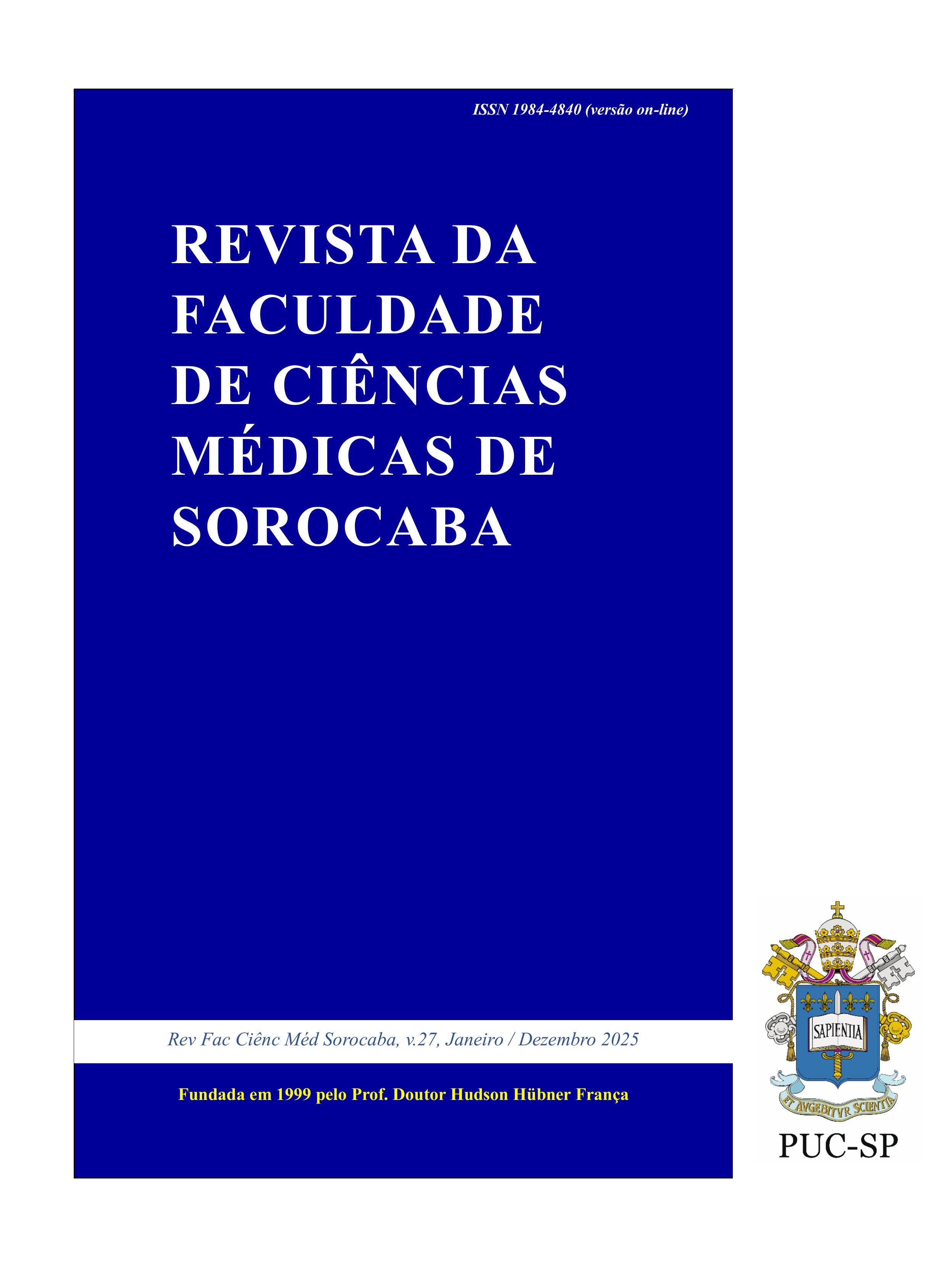Assessment of quality of life and nasal peak flow in the post-operative surgery of rhinoseptoplasty and lower turbinectomy
DOI:
https://doi.org/10.23925/1984-4840.2025v27a4Keywords:
Rinoplasty, Nasal Septum/surgery, Peak Expiratory Flow Rate, Nasal Obstruction, Visual Analog ScaleAbstract
Objectives: To compare three subjective methods with an objective method for evaluating nasal obstruction in patients undergoing functional nasal surgeries and to analyze the effectiveness of these surgeries in the early (35 to 45 days) and late (six months) postoperative periods. Methods: Thirty-five patients undergoing functional nasal surgery were evaluated at three different time points: preoperatively, early postoperatively (30 to 45 days), and late postoperatively (after six months), using the objective method Inspiratory Nasal Peak Flow and subjective scales - Visual Analog Scale (VAS), Nasal Index Score (NIS), and Nasal Obstruction Symptom Evaluation (NOSE) scale. Results: All methods proved efficient in evaluating patients undergoing rhinoseptoplasty and inferior turbinectomy with nasal obstruction in the early and late postoperative periods. Inspiratory Nasal Peak Flow showed an average improvement of 100% in inspiratory flow. The subjective scales NOSE, NIS, and VAS also showed significant improvement in nasal obstruction and quality of life. When comparing the NOSE, NIS, and VAS scales with Inspiratory Nasal Peak Flow, no disparity was found between the preoperative results and the early and late postoperative results. Conclusion: There is a strong correlation between the methods used (NOSE, NIS, VAS, and Inspiratory Nasal Peak Flow) and the clinical status of the patients, making any of them suitable for evaluating nasal obstruction and quality of life.
References
Caldas Neto S; Mello Júnior JF, Martins RHG. Tratado de otorrinolaringologia e cirurgia cervicofacial. Rio de Janeiro: Roca; 2011. cap. 14, p. 260-1.
Braz F, Abrahao AR, Borges GC. Avaliação da qualidade de vida e peak flow nasal em pós-operatório de cirurgias funcionais (turbinectomia e/ou septoplastia) em pacientes com obstrução nasal crônica. Rev Fac Ciênc Méd Sorocaba [Internet]. 2015 [acesso em 10 jul 2023];17Supl). Disponível em: Disponível em: https://revistas.pucsp.br/index.php/RFCMS/article/view/24917
Surtel A, Klepacz R, Wysokińska-Miszczuk J. [The influence of breathing mode on the oral cavity]. Pol Merkur Lekarski. 2015;39(234):405-7.
Adil E, Huntley C, Choudhary A, Carr M. Congenital nasal obstruction: clinical and radiologic review. Eur J Pediatr. 2012;171(4):641-50. doi: 10.1007/s00431-011-1591-6.
Arunachalam PS, Kitcher E, Gray J, Wilson JA. Nasal septal surgery: evaluation of symptomatic and general health outcomes. Clin Otolaryngol Allied Sci. 2001;26(5):367-70. doi: 10.1046/j.0307-7772.2001.00481.x.
Konstantinidis I, Triaridis S, Triaridis A, Karagiannidis K, Kontzoglou G. Long term results following nasal septal surgery: focus on patients’ satisfaction. Auris Nasus Larynx. 2005;32(4):369-74. doi: 10.1016/j.anl.2005.05.011.
Gandomi B, Bayat A, Kazemei T. Outcomes of septoplasty in young adults: the Nasal Obstruction Septoplasty Effectiveness study. Am J Otolaryngol. 2010;31(3):189-92. doi: 10.1016/j.amjoto.2009.02.023.
Branco A, Ferrari GF, Weber SA. Alterações orofaciais em doenças alérgicas de vias aéreas. Rev Paul Pediatr. 2007;25(3):266-70. doi: 10.1590/ S0103-05822007000300012.
Cottle MH, loring RM. Surgery of the nasal septum; new operative procedures and indications. Ann Otol Rhinol Laryngol. 1948;57(3):705-13. doi: 10.1177/000348944805700309.
Stewart MG, Smith TL, Weaver EM, Witsell DL, Yueh B, Hannley MT, et al. After nasal septoplasty: results from the Nasal Obstruction Septoplasty effectiveness (NOSE) study. Otolaryngol Head Neck Surg. 2004;130(3):283-90. doi: 10.1016/j. otohns.2003.12.004.
Harrill WC, Pillsbury HC 3rd, McGuirt WF, Stewart MG. Radiofrequency turbinate reduction: a NOSE evaluation. Laryngoscope. 2007;117(11):1912-9. doi: 10.1097/MLG.0b013e3181271414.
Priftis KN, Papadimitriou N, Anthracopoulos MB. Should we perform objective assessment of nasal obstruction in children with chronic rhinitis? J Pediatr. 2012;88(5):374- 6. doi: 10.2223/JPED.2235.
Klimek L, Bergmann KC, Biedermann T, Bousquet J, Hellings P, Jung K, et al. Visual analogue scales (VAS): Measuring instruments for the documentation of symptoms and therapy monitoring in cases of allergic rhinitis in everyday health care: Position Paper of the German Society of Allergology (AeDA) and the German Society of Allergy and Clinical Immunology (DGAKI), ENT Section, in collaboration with the working group on Clinical Immunology, Allergology and Environmental Medicine of the German Society of Otorhinolaryngology, Head and Neck Surgery (DGHNOKHC). Allergo J Int. 2017;26(1):16-24. doi: 10.1007/s40629-016-0006-7.
Bezerra TFP, Stewart MG, Fornazieri MA, Pilan RRM, Pinna FR, Padua FGM, et al. Avaliação da qualidade de vida após septoplastia em pacientes com obstrução nasal. Braz J Otorhinolaryngol. 2012;78(3):57-62.
Cavaliere M, Mottola G, Iemma M. Comparison of the effectiveness and safety of radiofrequency turbinoplasty and traditional surgical technique in treatment of inferior turbinate hypertrophy. Otolaryngol Head Neck Surg. 2005;133(6):972-8. doi: 10.1016/j. otohns.2005.08.006.
Rodrigues MM, Dibbern RS, Oliveira LFD, Marques MDO. Comparison between turbinoplasty and endoscopic turbinectomy: efficacy and clinical parameters. Int Arch Otorhinolaryngol. 2011;15(4):426-30. doi: 10.1590/S1809-48722011000400004.
Downloads
Published
How to Cite
License
Copyright (c) 2025 Revista da Faculdade de Ciências Médicas de Sorocaba

This work is licensed under a Creative Commons Attribution-NonCommercial 4.0 International License.
Os autores no momento da submissão transferem os direitos autorais, assim, os manuscritos publicados passam a ser propriedade da revista.
O conteúdo do periódico está licenciado sob uma Licença Creative Commons 4.0, esta licença permite o livre acesso imediato ao trabalho e que qualquer usuário leia, baixe, copie, distribua, imprima, pesquise ou vincule aos textos completos dos artigos, rastreando-os para indexação, passá-los como dados para o software, ou usá-los para qualquer outra finalidade legal.

 Este obra está licenciada com uma Licença
Este obra está licenciada com uma Licença 